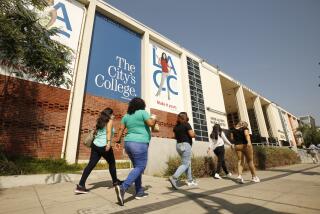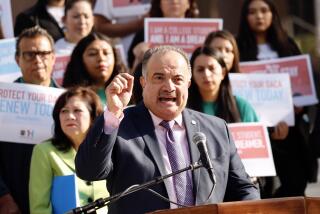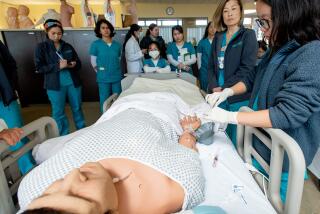$3.7 Million in Improvements Considered for LBCC Campus
LONG BEACH — After decades of indecision about the proper use of the Pacific Coast Campus, Long Beach Community College trustees are considering investing $3.7 million in the facility and declaring it a center for vocational education and classes in English as a second language.
A staff proposal presented to the board of trustees Tuesday says that the Pacific Coast campus should “be thought of as other than a full-service campus.” It recommends dropping some services, strengthening others and overhauling the physical plant to make the campus more useful, more attractive and more cost-efficient.
The proposal suggests that the board sell or lease excess property--such as a vacant, 11.5-acre parcel north of Alamitos Avenue, appraised at $3.5 million to $4.5 million a year ago--to raise funds to renovate buildings. Projections also call for a $2-million surplus in the district capital improvements fund at the end of this year, which could be used to finance improvements. Another $400,000 could come from state grants that have been applied for by the district.
Gymnasium May Be Converted
Part of the money could be used to convert the gymnasium into a center that would house counseling, job placement and financial aid offices, a library and seven learning-assistance programs, which are now scattered in classrooms needed for other uses.
Under the proposal, the cafeteria, which is expected to lose $15,000 this year, would be converted into a multipurpose room that could be used for exercise classes. A food stand would be opened on campus, possibly in the center of a grassy mall that is also proposed.
The mall would diagonally bisect the main parking lot to unify the school. The large, unlandscaped parking lot now separates the northern half of the campus --which contains technical and trade courses--from the older, southern half --which houses English as a second language classes, the gymnasium, cafeteria and most academic classes.
The proposal also calls for overhauling the electrical system, resurfacing parking lots, remodeling the fine arts and automotive buildings and adding a new entrance on Walnut Avenue. The May Avenue entrance, which is considered unsafe now because motorists enter it by making left turns off Pacific Coast Highway, would be closed to all but right-turn traffic.
Pacific Coast accommodates about 20% of the students who attend Long Beach City College, and its site is a little more than half the size of the Liberal Arts Campus across town on Carson Street, near Lakewood Boulevard.
Long Beach City College acquired the former junior high school site in 1949, and since then it has been used mostly for vocational classes and business education. English as a second language has also become a major department in recent years.
The campus, on Pacific Coast Highway about two miles east of the Long Beach Freeway, now houses all of the college’s technical, trade and industrial classes and most of the secretarial- and clerical-train
ing classes. All but six of about 60 English as a second language classes are taught at the Pacific Coast Campus.
Some entry-level vocational education classes may be moved to Pacific Coast from the main campus if the board adopts the proposal, said Bill Barnes, dean of the Pacific Coast campus.
‘Commitment to Site’
“The (instructional) changes appear to be more dramatic than they actually are,” said Barnes. “The important thing is that if the board accepts this, it puts them on record with 500 staff members with a commitment to the site. The problem has been the indecision.”
Barbara Kalbus, vice president of academic affairs, said that courses would continue to be offered to students interested in earning an associate of arts degree in conjunction with their technical certificates.
Trustees will decide May 13 whether to give the plan preliminary approval. Supt. John McCuen and board president Trudy Polsky both predicted some version of it will be adopted.
“I’m certain there will be some modification of the plan as we go along,” Polsky said. “Right now, I have no criticism of it whatsoever.”
Administrators say they hope adoption of the plan will end what McCuen called “the several decades’ agony of not knowing from one year to the next if there is even going to be a (Pacific Coast) campus.”
Ongoing Speculation
Board members, though, insist that in recent years they have not considered scuttling the campus, which serves 8,000 students. But because it has been operating with a one-room library, a money-losing cafeteria, inadequate classroom space, parking lots that flood in a heavy rain and no firm consensus on its purpose, the campus’ future has been the object of ongoing speculation.
“The faculty (at Pacific Coast) is constantly on edge because of the uncertainty of things,” said Eric David, who taught at the campus part-time for five years before getting a full-time teaching job at the main campus.
He called the prospect of improvements “a carrot that has always been held out in front of the horse.”
This is the 10th study of the Pacific Coast Campus undertaken by the district in the last 30 years. A 1965 study recommended closing the campus and consolidating services at the main campus. The study was partly implemented in the late 1960s when several technical departments were moved to the main campus.
The 1974 Pacific Coast Master Plan recommended $10 million worth of improvements to the campus, which would cost an estimated $15 million today. That plan was never carried out because of lack of money.
Weekly Meetings
“A real cynicism has set in because people have heard all the big grandiose plans that haven’t come to anything,” said Jim Kossler, acting vice president of administrative services, who headed the Pacific Coast Campus Project Task Force. Kossler said a team of six administrators met weekly for a year to prepare this proposal.
“We considered lots and lots of alternatives,” Kossler said. “This is what’s do-able. We hope it will be a clear signal that this campus is an integral part of the college.”
That will be a new message for some discontented students.
“We seem to get all the hand-me-downs here,” said Rochelle Hutson, 27, of Long Beach. “The other campus has better everything.”
Hutson, who is not currently enrolled, took pre-nursing classes at the Pacific Coast Campus last semester. She was on campus last week to play table tennis in the student game room, which is being considered as a site for the new food facility. She is also an avid volleyball player. If the gymnasium is converted, volleyball classes would no longer be offered at the Pacific Coast campus.
Reaction to Trade-Offs
“They’re always taking something away,” she said when she heard about the trade-offs.
Volleyball is the only sport that would be dropped as a result of converting the gymnasium, Barnes said.
Ten to 12 classrooms would be freed for classes in English as a second language. Those courses have six allocated rooms and up to 28 classes in session at once. Teachers say they are accepting 45 students in some classes and meeting in home economics rooms, shop classes and anywhere else they can find space.
Bernice Weiss, chairwoman of the English as a second language department, said 2,500 students enroll in the department’s classes at Long Beach City College each year.
More to Read
Sign up for Essential California
The most important California stories and recommendations in your inbox every morning.
You may occasionally receive promotional content from the Los Angeles Times.










